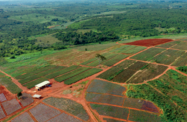Rice production in Ghana has come under scrutiny in recent years, as the government works to reduce its agricultural imports by boosting domestic production. A number of state-led initiatives are aimed at improving output, while the private sector is playing an increasingly important role.
Growth plans
Under the 2009 National Rice Development Strategy (NRDS), the Ministry of Food and Agriculture (MoFA) wants to double rice production by 2018. Among other goals, the NRDS seeks to improve land and water management practices, improve access to government services and establish partnerships with the private sector.
One government-led initiative, the five-year Project for Sustainable Development of Rain-Fed Lowland Rice Production, was launched in 2009 to promote local production and improve the economic conditions of small-scale farmers. The programme is being run in partnership with the Japan International Cooperation Agency (JICA), which in September announced that output in the Ashanti region had increased from 1.2 tonnes per ha in 2009 to 5.4 tonnes in 2012.
This would place the region well above the national average yield, which stood at 2.5 tonnes per ha as of 2012, far below the 6.5 tonnes per ha that MoFA says is achievable. While average yield rates have improved country-wide – they stood at 2.2 tonnes as of 2000 – and the amount of land dedicated to rice production has increased by 70% over the past decade, Ghana is unable to meet local demand.
Estimates vary, but it is thought that more than half of the rice consumed is imported. Leticia Osafo Addo, the CEO of Samba Foods, a local food processor, told the Ghana News Agency in July that about 70% of rice is purchased from abroad. According to the US Department of Agriculture, Ghana can produce around 275,000 tonnes of rice for human consumption, compared to an estimated 600,000 tonnes that it will purchase from international sources in 2013.
These imports are not cheap. MoFA says that foreign rice purchases cost an estimated $450m each year. It is expensive relative to local products – as of December 2012, imported rice cost GHS2.36 ($1.20) per kg, compared to GHS0.97 ($0.49) for domestic varieties.
Changing attitudes
The prevalence of imports despite this price differential may have to do with a perception that foreign rice, particularly perfumed varieties such as jasmine or basmati, is of higher quality and offers a better nutritional value. Nicholas Neequaye, deputy head of research and policy at MoFA, said changing that attitude will be critical to boosting the domestic rice market. “We have had some quality issues compared to imports from Thailand in the past, but practices have improved and I can say with confidence that our local varieties are more nutritious than polished imports,” he told OBG.
Others have suggested the domestic suppliers lack the necessary investment capital to carry out downstream activities, including milling and marketing. “Local rice is not low-quality; it’s just not backed by a commercial business model. You need a high-quality mill, packaging, branding and credit before you can access the market. For local producers to access the market, they need an investment capability that is not within their reach,” Amit Agrawal, senior vice-president for West Africa at Olam, one of the largest rice importers in Ghana, told OBG.
Private sector investment
However, the nature of the domestic supply is evolving and becoming more sophisticated, in part due to foreign investments in rice farming.
In April 2013 American multi-national AVCO Agri Company acquired 500 ha of land in the Volta Region for rice cultivation, announcing plans to invest some $500,000 in the next three to five years.
Another outfit, Global Agri-Development Company (GADCO), signed a 30-year lease in 2011 on 1000 ha of land to develop high-quality rice crops. Today GADCO, which was established with the input of Brazilian agriculture experts, produces two annual harvests over 1600 ha of land, and plants new paddies each month. High capital demands are the most common causes of rice farm failures, but GADCO sourced $15m in its first investment phase.
The state is also making investments and improving access to technology for local farmers. Under the Agriculture Machine Subsidy Programme, rice combine harvesters were made available at Agricultural Mechanisation Service Centres (AMSECs) across 64 districts, with training provided to 400 operators. In 2013 the MoFA will provide 50 rice threshers to small-scale rice farms at its network of AMSECs.
Though misperceptions regarding the nutritional value of local rice and post-harvest inefficiencies have hindered domestic growth, increased demand should help local farmers leverage yields and expand operations. And while government programmes have already helped the sector grow, increased private investment in rice farms is likely necessary if the country hopes to meet its ambitious rice targets by 2018.

